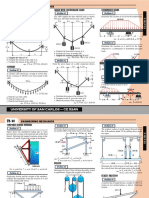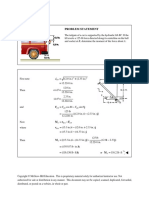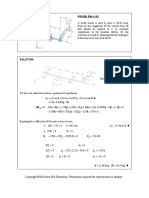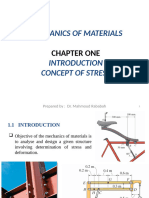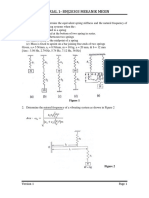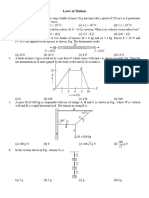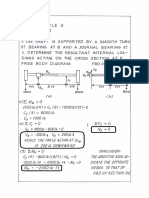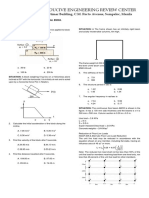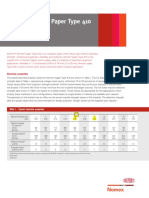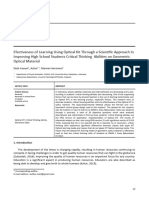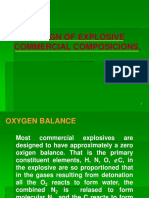Exercices Mécanique
Exercices Mécanique
Uploaded by
Tom ThibertCopyright:
Available Formats
Exercices Mécanique
Exercices Mécanique
Uploaded by
Tom ThibertCopyright
Available Formats
Share this document
Did you find this document useful?
Is this content inappropriate?
Copyright:
Available Formats
Exercices Mécanique
Exercices Mécanique
Uploaded by
Tom ThibertCopyright:
Available Formats
PROBLEM 16.
A uniform rod BC of mass 4 kg is connected to a collar A by a 250-mm
cord AB. Neglecting the mass of the collar and cord, determine (a) the
smallest constant acceleration aA for which the cord and the rod lie in a
straight line, (b) the corresponding tension in the cord.
SOLUTION
Geometry and kinematics:
Distance between collar and floor AD 250 mm 350 mm 600 mm
When cord and rod lie in a straight line:
AC AB BC 250 mm 400 mm 650 mm
AD 600 mm
cos
AC 650 mm
22.62
Kinetics
(a) Acceleration at A.
M C ( M C )eff : W (CG )sin ma (CG ) cos
ma mg tan
a g tan (9.81 m/s 2 ) tan 22.62
aA a 4.09 m/s 2
(b) Tension in the cord.
Fx ( Fx )eff : T sin ma mg tan
mg (4 kg)(9.81)
T T 42.5 N
cos cos 22.62
Copyright © McGraw-Hill Education. Permission required for reproduction or display.
PROBLEM 16.11
A completely filled barrel and its contents have a combined
mass of 90 kg. A cylinder C is connected to the barrel at a
height h 550 mm as shown. Knowing s 0.40 and
k 0.35, determine the maximum mass of C so the barrel
will not tip.
SOLUTION
Kinematics: Assume that the barrel is sliding, but not tipping.
0 aG a
Since the cord is inextensible, aC a
Kinetics: Draw the free body diagrams of the barrel and the cylinder. Let T be the tension in the cord.
The barrel is sliding. FF k N 0.35 N
Assume that tipping is impending, so that the line of action of the reaction on the bottom of the barrel passes
through Point B.
e 250 mm
For the barrel. Fy 0: N WB 0 N WB mB g 882.90 N
M G 0: Ne 100T (450)(0.35 N ) 0
e (450)(0.35) 250 157.5
T N (882.90) 816.68 N
100 100
Fx mB a : T 0.35 N mB a
816.68 882.90
a 0.35 5.6407 m/s2
90 90
Copyright © McGraw-Hill Education. Permission required for reproduction or display.
PROBLEM 16.11 (Continued)
For the cylinder: F mC a : WC T mC a
mC g T mC a
T 816.68
mC 195.88 kg
g a 9.81 5.6407
mC 195.9 kg
Copyright © McGraw-Hill Education. Permission required for reproduction or display.
PROBLEM 16.14
Bars AB and BE, each of mass 4 kg, are welded together and are pin-
connected to two links AC and BD. Knowing that the assembly is
released from rest in the position shown and neglecting the masses of
the links, determine (a) the acceleration of the assembly, (b) the forces
in the links.
SOLUTION
Given: mAB mBE 14 kg
Free Body Diagram:
Kinetics: M G 0 FA 0
F BG 8 9.81 0.5 8 kg a
g
a 4.905 m/s2 or a
2
F BG FB 78.48 N 0.866 0
FB 67.966 N
(a) a 4.91 m/s 2 30
(b) FA 0, FB 68.0 N compression
Copyright © McGraw-Hill Education. Permission required for reproduction or display.
PROBLEM 16.15
At the instant shown the tensions in the vertical ropes AB and
DE are 300 N and 200 N, respectively. Knowing that the mass
of the uniform bar BE is 5 kg, determine, at this instant, (a) the
force P, (b) the magnitude of the angular velocity of each rope,
(c) the angular acceleration of each rope.
SOLUTION
Given: TAB 300 N, TDE 200 N, m BE 5 kg
Free Body Diagram:
Kinetics:
M G 0 200 0.6 0.866 300 0.6 0.866 P 0.6 0.5
(a) P 173.2 N
Fy 300 5 9.81 200 5 0.4 2
(b) = 15.02 rad/s
Fx P 5 0.4 173.2
(c) = 86.6 rad/s 2
Copyright © McGraw-Hill Education. Permission required for reproduction or display.
PROBLEM 16.16
Three bars, each of mass 3 kg, are welded together and are pin-
connected to two links BE and CF. Neglecting the weight of the
links, determine the force in each link immediately after the system
is released from rest.
SOLUTION
Mass center of ABCD is at G
mi yi 3(0.225) 3(0.225) 3(0)
y 0.15 m
mi 9
W mg
40 F Feff : mg cos50 ma
(9.81 m/s 2 ) cos 50 a
a 6.3057 m/s2 40
M B ( M B )eff :
( FCF sin 50)(0.450 m) (9 kg)(9.81 m/s 2 )(0.225 m) ma sin 40(0.225 m) ma cos 40(0.150 m)
0.34472 FCF 19.8653 ma (0.14463 0.11491)
0.34472 FCF 19.8653 9(6.3057)(0.25953)
FCF 14.8998 N FCF 14.90 N compression
50° F Feff : FBE 14.9 lb (9 kg)(9.81)sin 50 0
FBF 52.734 N FBE 52.7 N compression
Copyright © McGraw-Hill Education. Permission required for reproduction or display.
PROBLEM 16.32
In order to determine the mass moment of inertia of a flywheel of radius
600 mm, a 12-kg block is attached to a wire that is wrapped around the
flywheel. The block is released and is observed to fall 3 m in 4.6 s. To
eliminate bearing friction from the computation, a second block of mass 24 kg
is used and is observed to fall 3 m in 3.1 s. Assuming that the moment of the
couple due to friction remains constant, determine the mass moment of inertia
of the flywheel.
SOLUTION
Kinematics: Kinetics:
M B ( M B ) eff : ( m A y ) r M f I ( m A a ) r
a
mA gr M f I mA ar (1)
r
Case 1: y 3m
t 4.6 s
1 2
y at
2
1
3 m a(4.6 s)2
2
a 0.2836 m/s2
mA 12 kg
Substitute into Eq. (1)
0.2836 m/s2
(12 kg)(9.81 m/s2 )(0.6 m) M f I 2
(12 kg)(0.2836 m/s )(0.6 m)
0.6 m
70.632 M f I (0.4727) 2.0419 (2)
Copyright © McGraw-Hill Education. Permission required for reproduction or display.
PROBLEM 16.50
A force P of magnitude 3 N is applied to a tape wrapped
around the body indicated. Knowing that the body rests
on a frictionless horizontal surface, determine the
acceleration of (a) Point A, (b) Point B.
A thin hoop of mass 2.4 kg.
SOLUTION
Hoop: I mr 2
Fx ( Fx )eff : P ma
P
a
m
M G ( M G )eff : Pr I mr 2
P
α
mr
(a) Acceleration of Point A.
P P P
aA a r r 2
m mr m
3N
aA 2 2.5 m/s 2 a A 2.50 m/s 2
2.4 kg
(b) Acceleration of Point B.
P P
aB a r r 0 aB 0
m mr
Copyright © McGraw-Hill Education. Permission required for reproduction or display.
PROBLEM 16.64
A beam AB of mass m and of uniform cross section is suspended
from two springs as shown. If spring 2 breaks, determine at that
instant (a) the angular acceleration of the beam, (b) the
acceleration of point A, (c) the acceleration of point B.
SOLUTION
2mg
Fy maG
3
mg L 1
M G mL2
3 2 12
2g 2g
(a) aG ,
3 L
2g 2g L g
(b) aA
3 L 2 3 ,
g
aA
3
2g 2g L 5g
(c) aB
3 L 2 3
5g
aB
3
Copyright © McGraw-Hill Education. Permission required for reproduction or display.
PROBLEM 16.67
A thin plate of the shape indicated and of mass m is suspended from two
springs as shown. If spring 2 breaks, determine the acceleration at that
instant (a) of point A, (b) of point B.
A thin hoop of diameter b.
SOLUTION
2
b 1
I m mb 2
2 4
1 1
Statics: T1 T2 W mg
2 2
Kinetics: M G M G eff :
b
T1 I
2
1 b 1
mg mb2
2 2 4
g
α
b
Fy Fy eff : W T ma
1 1
mg mg ma a g
2 2
Kinematics:
Plane motion Translation Rotation
b 1 b g
(a) a A aG a A/G a g ; aA 0
2 2 2 b
b 1 b g
(b) a B aG a B/G a g ; aB g
2 2 2 b
Copyright © McGraw-Hill Education. Permission required for reproduction or display.
PROBLEM 16.83
A turbine disk of mass 26 kg rotates at a constant rate of 9600 rpm. Knowing
that the mass center of the disk coincides with the center of rotation O,
determine the reaction at O immediately after a single blade at A, of mass
45 g, becomes loose and is thrown off.
SOLUTION
2
9600 rpm
60
320 rad/s
Consider before it is thrown off.
F Feff : R man mF 2
(45 103 kg)(0.3 m)(320 )2
R 13.64 kN
Before blade was thrown off, the disk was balanced ( R 0). Removing vane at A also removes its reaction,
so disk is unbalanced and reaction is
R 13.64 kN
Copyright © McGraw-Hill Education. Permission required for reproduction or display.
PROBLEM 16.95
A homogeneous sphere S, a uniform cylinder C, and a thin pipe P
are in contact when they are released from rest on the incline
shown. Knowing that all three objects roll without slipping,
determine, after 4 s of motion, the clear distance between (a) the
pipe and the cylinder, (b) the cylinder and the sphere.
SOLUTION
General case: I mk 2 a r
M C ( M C )eff : ( w sin )r I mar
mg sin r mk 2 mr 2
r sin
r2 k 2
rg sin r2
a r r a g sin (1)
r2 k 2 r2 k 2
r2 1
For pipe: k r aP 2 2
g sin g sin
r r 2
1 r2 2
For cylinder: k2 aC 2
g sin g sin
2 r 3
r2
2
2 r2 5
For sphere: k2 aS g sin g sin
5 2 7
r2 r2
5
(a) Between pipe and cylinder.
2 1 1
aC/P aC aP g sin g sin
3 2 6
1 11
xC/P aC /P t 2 g sin t 2
2 26
11
SI units: xC/P 9.81 m/s 2 sin10(4 s) 2 2.27 m
26
11
US units: xC/P 32.2 ft/s2 sin10(4 s)2 7.46 ft
26
Copyright © McGraw-Hill Education. Permission required for reproduction or display.
PROBLEM 16.95 (Continued)
(b) Between sphere and cylinder.
5 2 1
aS/C aS aC g sin g sin
7 3 21
1 1 1
xS/C aS/C t 2 g sin t 2
2 2 21
1 1
SI units: xS/C 9.81 m/s2 sin10(4 s)2 0.649 m
2 21
1 1
US units: xS/C 32.2 ft/s 2 sin10(4 s)2 2.13 ft
2 21
Copyright © McGraw-Hill Education. Permission required for reproduction or display.
PROBLEM 16.96
A 40-kg flywheel of radius R 0.5 m is rigidly attached to a shaft of radius
r 0.05 m that can roll along parallel rails. A cord is attached as shown and
pulled with a force P of magnitude 150 N. Knowing the centroidal radius of
gyration is k 0.4 m, determine (a) the angular acceleration of the
flywheel, (b) the velocity of the center of gravity after 5 s.
SOLUTION
Mass and moment of inertia: m 40 kg
I mk 2 (40 kg)(0.4 m)2 6.4 kg m 2
Kinematics: (no slipping) a r 15°
Kinetics:
Let Point C be the contact point between the flywheel and the rails.
M C ( M C )eff : P ( R r ) mgr sin15 I (ma )r
P( R r ) mgr sin15 ( I mr 2 )
(a) Angular acceleration of the f lywheel.
P( R r ) mgr sin15
I mr 2
(150 N)(0.55 m) (40 kg)(9.81 m/s2 )(0.05 m)sin15
(6.4 kg m 2 ) (40 kg)(0.05 m)2
11.911 rad/s 2 α 11.91 rad/s 2
Copyright © McGraw-Hill Education. Permission required for reproduction or display.
PROBLEM 16.99
A drum of 60-mm radius is attached to a disk of 120-mm radius. The
disk and drum have a total mass of 6 kg and a combined radius of
gyration of 90 mm. A cord is attached as shown and pulled with a force P
of magnitude 20 N. Knowing that the disk rolls without sliding,
determine (a) the angular acceleration of the disk and the acceleration of
G, (b) the minimum value of the coefficient of static friction compatible
with this motion.
SOLUTION
a r (0.12 m)
I mk 2
(6 kg)(0.09 m) 2
I 48.6 103 kg m 2
M C ( M C )eff : (20 N)(0.18 m) (ma )r I
3.6 N m (6 kg)(0.12 m)2 48.6 kg m 2
3.6 135 103
(a) 26.667 rad/s2 α 26.7 rad/s 2
a r (0.12 m)(26.667 rad/s2 )
3.2 m/s2 a 3.20 m/s 2
(b) Fy ( Fy )eff : N mg 0
N (6 kg)(9.81 m/s 2 ) N 58.86 N
Fx ( Fx )eff : 20 N F ma
20 N F (6 kg)(3.2 m/s 2 ) F 0.8 N
F 0.8 N
( s ) min ( s )min 0.0136
N 58.86 N
Copyright © McGraw-Hill Education. Permission required for reproduction or display.
PROBLEM 16.101
A drum of 60-mm radius is attached to a disk of 120-mm radius. The disk and
drum have a total mass of 6 kg and a combined radius of gyration of 90 mm. A
cord is attached as shown and pulled with a force P of magnitude 20 N.
Knowing that the disk rolls without sliding, determine (a) the angular
acceleration of the disk and the acceleration of G, (b) the minimum value of
the coefficient of static friction compatible with this motion.
SOLUTION
a r (0.12 m)
I mk 2
(6 kg)(0.09 m) 2
I 48.6 kg m 2
M C ( M C )eff : (20 N)(0.06 m) (ma )r I
1.2 N m (6 kg)(0.12 m) 2 (48.6 103 kg m 2 )
1.2 135 103
(a) 8.889 rad/s2 α 8.89 rad/s 2
a r (0.12 m)(8.889 rad/s 2 )
1.0667 m/s 2 a 1.067 m/s 2
(b) Fy ( Fy )eff : N 20 N mg 0
N 20 N (6 kg)(9.81 m/s 2 ) N 38.86 N
Fx ( Fx )eff : F ma
F (6 kg)(1.0667 m/s 2 ) F 6.4 N
F 6.4 N
( s ) min ( s )min 0.165
N 38.86 N
Copyright © McGraw-Hill Education. Permission required for reproduction or display.
PROBLEM 16.114
A small clamp of mass mB is attached at B to a hoop of mass mh . The system is
released from rest when 90 and rolls without sliding. Knowing that
mh 3mB , determine (a) the angular acceleration of the hoop, (b) the horizontal
and vertical components of the acceleration of B.
SOLUTION
Kinematics: a A r , aB/A r
aB a A a B/ A
a B r r
(a B ) x r (aB ) y r
Kinetics:
mh 3mB
I mh r 2 3mB r 2
(a) Angular acceleration.
M C ( M C ) eff : WB r I mh a A r m B ( a B ) x r m B ( a B ) y r
mB gr 3mB r 2 (3mB )r 2 mB r 2 mB r 2
1g
gr 8r 2
8r
(b) Components of acceleration of B.
1 1
(a B ) x r g (a B ) y r g
8 8
1
(aB ) x g
8
1
(a B ) y g
8
Copyright © McGraw-Hill Education. Permission required for reproduction or display.
PROBLEM 16.115
A small clamp of mass mB is attached at B to a hoop of mass mh. Knowing that the
system is released from rest and rolls without sliding, derive an expression for the
angular acceleration of the hoop in terms of mB, mh, r, and .
SOLUTION
Kinematics: a A r aB/ A r
aB aA aB/ A
a B r r
Kinetics: I mh r 2
M C ( M C )eff : WB r sin I mh a A r mB r (r r cos ) mB r sin (r sin )
mB r cos (r r cos )
mB gr sin mh r 2 mh (r )r mB r (1 cos )( r r cos )
mB r sin (r sin )
mB gr sin 2mh r 2 mB r 2 [(1 cos ) 2 sin 2 ]
2mh r 2 mB r 2 [1 2cos cos 2 sin 2 ]
g mB sin
mB gr sin r 2 [2mh mB (2 2cos )]
2r mh mB (1 cos )
Copyright © McGraw-Hill Education. Permission required for reproduction or display.
PROBLEM 16.118
The 10-lb-uniform rod AB has a total length 2L = 2 ft and is
attached to collars of negligible mass that slide without friction
along fixed rods. If rod AB is released from rest when 30,
determine immediately after release (a) the angular acceleration of
the rod, (b) the reaction at A.
SOLUTION
W 10 lb
m 0.3106 slugs
g 32.2 ft/s 2
L 1 ft
From P16.117
32.2 ft/s 2 sin 30
27.600 rad/s 2
1.0 ft 1
3
sin 2 30
or 27.6 rad/s 2
0.3106 slugs 32.2 ft/s 2
A 5.714 lbs
1 3sin 2 30
or A 5.714 lb
Copyright © McGraw-Hill Education. Permission required for reproduction or display.
PROBLEM 16.124
The 4-kg uniform rod ABD is attached to the crank BC and is fitted with
a small wheel that can roll without friction along a vertical slot. Knowing
that at the instant shown crank BC rotates with an angular velocity of 6
rad/s clockwise and an angular acceleration of 15 rad/s2
counterclockwise, determine the reaction at A.
SOLUTION
Crank BC:
BC 0.1 m
(aB )t ( BC ) (0.1 m)(15 rad/s 2 ) 1.5 m/s 2 (a B )t 1.5 rad/s2
(aB )n ( BC ) 2 (0.1 m)(6 rad/s)2 3.6 m/s 2 (a B )n 3.6 m/s 2
BC 0.1 m
Rod ABD: sin 1 sin 1 30
AB 0.2 m
a A a B a A /G
[aA ] [1.5 3.6 ] [0.2 ]
0 3.6 (0.2 ) cos
3.6 18
20.78 rad/s 2 α 20.78 rad/s 2
0.2cos cos 30
Kinetics:
1
M G ( M G )eff : A(0.1732 m) I m L2
12
1
(4 kg)(0.4 m) 2 (20.78 rad/s 2 )
12
A 6.399 N A 6.40 N
Copyright © McGraw-Hill Education. Permission required for reproduction or display.
PROBLEM 16.154
The forklift truck shown weighs 2250 lb and is
used to lift a crate of weight W 2500 lb. The
truck is moving to the left at a speed of 10 ft/s
when the brakes are applied on all four wheels.
Knowing that the coefficient of static friction
between the crate and the fork lift is 0.30,
determine the smallest distance in which the truck
can be brought to a stop if the crate is not to slide
and if the truck is not to tip forward.
SOLUTION
Assume crate does not slide and that tipping impends about A. ( B 0)
M A ( M A )eff :
a a
(2500 lb)(3 ft) (2250 lb)(4 ft) 2500 (4 ft) 2250 (3 ft)
g g
a
7500 9000 (10, 000 6750)
g
a
0.09; a 0.09(32.2 ft/s 2 ) a 2.884 ft/s2
g
Uniformly accelerated motion
v 2 v02 2ax; 0 (10 ft/s)2 2(2.884 ft/s 2 ) x x 17.34 ft
Check whether crate slides
N W
W
F ma a
g
F a 2.884 ft/s 2
req
N g 32.2 ft/s 2
req 0.09 0.30. The crate does not slide.
Copyright © McGraw-Hill Education. Permission required for reproduction or display.
PROBLEM 16.163
Solve Problem 16.162, assuming that the plate is fitted with a single pin
at corner A.
Problem 16.162 The motion of a square plate of side 150 mm and mass
2.5 kg is guided by pins at corners A and B that slide in slots cut in a
vertical wall. Immediately after the plate is released from rest in the
position shown, determine (a) the angular acceleration of the plate,
(b) the reaction of corner A.
SOLUTION
Since both A and mg are vertical, ax 0 and a is
Kinematics:
L
AG 15 aG/ A ( AG ) 15
2
a aA a G/ A 15
a 0.183L 15
1
Kinetics: I mL2
6
Copyright © McGraw-Hill Education. Permission required for reproduction or display.
PROBLEM 16.163 (Continued)
(a) Angular acceleration.
M A ( M A )eff : mg ( AG )sin15 I ma ( AG )sin15
L 1 2 L
mg sin15 mL m(0.183L ) sin15
2 6 2
g 1
0.183 0.033494
L 6
g
0.183 0.2002
L
g
0.9143
L
9.81 m/s 2
0.9143 59.8 rad/s 2
0.15 m
(b) Reaction at corner A.
Fy ( Fy )eff : A mg ma
A mg m(0.183L )
g
m(0.183L) 0.9143
L
A mg 0.1673mg
A 0.8326mg
A 0.8326(2.5 kg)(9.81 m/s 2 ) A 20.4 N
Copyright © McGraw-Hill Education. Permission required for reproduction or display.
You might also like
- PSAD 2 May 3 2023Document17 pagesPSAD 2 May 3 2023Angelica Repollo100% (1)
- ENGINEERING MECHANICS REFRESHER SET Preboard 2022Document2 pagesENGINEERING MECHANICS REFRESHER SET Preboard 2022Marion Reinz MalubagNo ratings yet
- 58th DAE SSPS AnnouncementDocument2 pages58th DAE SSPS Announcementak86100% (1)
- Applied Mechanics I - Fall 2013 PDFDocument4 pagesApplied Mechanics I - Fall 2013 PDFRajeshGupta100% (1)
- DAY 1 - Statics, Dynamics, Strength of MaterialsDocument20 pagesDAY 1 - Statics, Dynamics, Strength of MaterialsJM De Guzman TuzonNo ratings yet
- ENGN.2050 Assignment 07 SolutionDocument4 pagesENGN.2050 Assignment 07 SolutionAri Meliasta Ginting04No ratings yet
- Solucionario Mecanica AnaliticaDocument4 pagesSolucionario Mecanica AnaliticaLeonel ArchilaNo ratings yet
- Ge201-Lecture 6 Equilibrium ExamplesDocument15 pagesGe201-Lecture 6 Equilibrium ExamplesNathanielle AndreaNo ratings yet
- 2 Engineering MechanicsDocument5 pages2 Engineering MechanicsAdrianne CespedesNo ratings yet
- File 1582710448 PDFDocument5 pagesFile 1582710448 PDFNatasha Marie MallareNo ratings yet
- 39 Trigonometric Functions CopyrightDocument10 pages39 Trigonometric Functions CopyrightcuaresmajhcNo ratings yet
- Newton Law of Motion - DPP 04 (Extra) - Arjuna JEE 2024Document6 pagesNewton Law of Motion - DPP 04 (Extra) - Arjuna JEE 2024supratimsinha181No ratings yet
- CH 5 - Beams and Frames - Part 2Document25 pagesCH 5 - Beams and Frames - Part 2Fawzia HassanNo ratings yet
- CELE-APRIL-2024-REFRESHER-PSAD5Document4 pagesCELE-APRIL-2024-REFRESHER-PSAD5zyozone8No ratings yet
- Topics Problem Set 9 - Structural Theory (Final) 1ST Term 2020-2021Document1 pageTopics Problem Set 9 - Structural Theory (Final) 1ST Term 2020-2021Levi John Corpin AmadorNo ratings yet
- Slayt 1Document23 pagesSlayt 1John Russell BinoboNo ratings yet
- Lecture 3 Equilibrium in 2-DDocument12 pagesLecture 3 Equilibrium in 2-Dnody.tarek2005No ratings yet
- Statics PROBLEMS SET 7 Final RequirementDocument14 pagesStatics PROBLEMS SET 7 Final Requirementramonedakyle82No ratings yet
- 9P Equilibrium of RigidBodies 2D 2018Document25 pages9P Equilibrium of RigidBodies 2D 2018Ömer faruk SilNo ratings yet
- Solution 3.11 Problem Statement: F I J I JDocument5 pagesSolution 3.11 Problem Statement: F I J I JPandji Arie NugrahaNo ratings yet
- PROBLEM 3.21: SolutionDocument3 pagesPROBLEM 3.21: SolutionYerly BohorquezNo ratings yet
- Tutorial 1,2,3Document8 pagesTutorial 1,2,3RameshNo ratings yet
- First Assessment Exam - Correlation Ii: AB Is 2400 NDocument45 pagesFirst Assessment Exam - Correlation Ii: AB Is 2400 NAlyssa Marie AsuncionNo ratings yet
- 82 - Engineering Mechanics Refresher SetDocument6 pages82 - Engineering Mechanics Refresher Setdevilene nayazakoNo ratings yet
- Statics of Rigid BodiesDocument3 pagesStatics of Rigid BodiesLove LilyNo ratings yet
- Practice Problems - Strema Part 3Document3 pagesPractice Problems - Strema Part 3Meverlyn RoqueroNo ratings yet
- DPP - 05 (Structural Anlaysis)Document4 pagesDPP - 05 (Structural Anlaysis)Ritesh SharmaNo ratings yet
- Chapter 13 2018Document38 pagesChapter 13 2018Sash 02No ratings yet
- PROBLEM 4.67: SolutionDocument3 pagesPROBLEM 4.67: SolutionAlan CazaNo ratings yet
- Inhouse Practice Problems - RCD-Column - Without AnswersDocument1 pageInhouse Practice Problems - RCD-Column - Without AnswersAndrea Sochayseng SolijonNo ratings yet
- CH-3 Equilibrium ExamplesDocument30 pagesCH-3 Equilibrium ExamplesHaftamu HilufNo ratings yet
- MECH003 HW2 SolnDocument3 pagesMECH003 HW2 SolnGregorio MacchiaNo ratings yet
- ENGN.2070 Assignment 21 SolutionDocument7 pagesENGN.2070 Assignment 21 SolutionAlexAnderAngeloNo ratings yet
- Applied Mechanics IDocument4 pagesApplied Mechanics IBikal BastakotiNo ratings yet
- 06Document12 pages06Meliza AnalistaNo ratings yet
- Solution Assignment Ch9Document5 pagesSolution Assignment Ch9Julian García100% (1)
- ENGN.2050-202 Assignment 15 Solution PDFDocument7 pagesENGN.2050-202 Assignment 15 Solution PDFVenkat DalaiNo ratings yet
- Mechanics of Materials Concept of Stress: Chapter OneDocument32 pagesMechanics of Materials Concept of Stress: Chapter Oneyousefkanaan1975No ratings yet
- Structural Theory Refresher SetDocument6 pagesStructural Theory Refresher SetLa BeamNo ratings yet
- EM AT-II Question SET-IDocument3 pagesEM AT-II Question SET-IMECH HODNo ratings yet
- JETS SENIOR PHYSICS Olympiads2016 (7 Files Merged) 081457Document69 pagesJETS SENIOR PHYSICS Olympiads2016 (7 Files Merged) 081457michaelchimbangu14No ratings yet
- Tutorial 1 (For Week 2 Tutorials)Document2 pagesTutorial 1 (For Week 2 Tutorials)2200851No ratings yet
- Tutorial 1 VibrationDocument6 pagesTutorial 1 VibrationNurRabbiyatulAddawiyyahNo ratings yet
- Laws of Motion - 24-01-24 - 01-24-2024-09-50-19-801 AMDocument5 pagesLaws of Motion - 24-01-24 - 01-24-2024-09-50-19-801 AMyashvi.jain0507No ratings yet
- Statics and Dynamics Quiz PRINCEDocument8 pagesStatics and Dynamics Quiz PRINCEMacatangay MhorienNo ratings yet
- 2022may Psad Unlocked CompressDocument5 pages2022may Psad Unlocked CompressJoshua UntalanNo ratings yet
- MG1 - L7 - C.7 - PDFedDocument27 pagesMG1 - L7 - C.7 - PDFedBreno PalluNo ratings yet
- VOL1Document3 pagesVOL1Ho BiNo ratings yet
- FINAL EXAM BAA 1113 Sem II 1718Document6 pagesFINAL EXAM BAA 1113 Sem II 1718naaaNo ratings yet
- Selfstudys Com FileDocument7 pagesSelfstudys Com FileSoumajit NathNo ratings yet
- Emailing Adobe Scan Sep 02, 2021Document8 pagesEmailing Adobe Scan Sep 02, 2021Kyle Garagara-MogolNo ratings yet
- Tutorial-1 Unit 2Document8 pagesTutorial-1 Unit 2Romharsh OliNo ratings yet
- Axially Loaded Member: Axial Load and Normal Stress Under Equilibrium Load, Elastic DeformationDocument16 pagesAxially Loaded Member: Axial Load and Normal Stress Under Equilibrium Load, Elastic DeformationHoda HosnyNo ratings yet
- 1 16Document19 pages1 16Frank PinedaNo ratings yet
- Structural Engg. Refresher (Oct. 13,2021)Document3 pagesStructural Engg. Refresher (Oct. 13,2021)Sadiri Roy D AragonNo ratings yet
- Exercises: Ans. F = 1404.917 N; θ = 7.05ºDocument3 pagesExercises: Ans. F = 1404.917 N; θ = 7.05ºRhey LuceroNo ratings yet
- Esplana SteelDesign3Document1 pageEsplana SteelDesign3Naigell SolomonNo ratings yet
- Preboard SDC 1Document7 pagesPreboard SDC 1Winter DeeneNo ratings yet
- Reviews in Computational ChemistryFrom EverandReviews in Computational ChemistryAbby L. ParrillNo ratings yet
- Development of A New Adaptive Backstepping Control Design For A Non-Strict and Under-Actuated System Based On A PSOTunerDocument17 pagesDevelopment of A New Adaptive Backstepping Control Design For A Non-Strict and Under-Actuated System Based On A PSOTunerMohammed Majid MsallamNo ratings yet
- Separating MixturesDocument8 pagesSeparating MixturesJames G. TalusanNo ratings yet
- 741 326Document2 pages741 326slymn100% (1)
- Modelacion Fisicomatematica Del Transporte de Metales PesadosDocument11 pagesModelacion Fisicomatematica Del Transporte de Metales PesadosdiegoNo ratings yet
- Star ChartsDocument38 pagesStar ChartsSoumya Ranjan100% (1)
- Fuzzy RelationsDocument23 pagesFuzzy RelationsdinkarbhombeNo ratings yet
- Flow Turndown RatioDocument8 pagesFlow Turndown RatioDeborah MalanumNo ratings yet
- (5 PTS) (1 PTS) : Test 1 MAT 1341C Feb. 7, 2009 1Document5 pages(5 PTS) (1 PTS) : Test 1 MAT 1341C Feb. 7, 2009 1examkillerNo ratings yet
- Measuring Neutron Fluence and Average Energy From H He Neutron Generators by Radioactivation TechniquesDocument12 pagesMeasuring Neutron Fluence and Average Energy From H He Neutron Generators by Radioactivation Techniquesdelta lab sangliNo ratings yet
- Assignment Fluid2Document8 pagesAssignment Fluid2Amier AziziNo ratings yet
- Power Loss in WAVEGUIDEDocument7 pagesPower Loss in WAVEGUIDEtorikulNo ratings yet
- 3 Improved Oil Recovery PDFDocument30 pages3 Improved Oil Recovery PDFhawar abdul-khaliq80% (5)
- Nomex410 TechSheet r6Document8 pagesNomex410 TechSheet r6vjNo ratings yet
- File Trigonometric Identities Worksheet 1 1643871081Document6 pagesFile Trigonometric Identities Worksheet 1 1643871081rajeev ranjanNo ratings yet
- Perspectives: The Impact of Construction Vibration On Adjacent StructuresDocument7 pagesPerspectives: The Impact of Construction Vibration On Adjacent Structuressofonias bezabehNo ratings yet
- AnyBody Tutorial 2011 V5Document229 pagesAnyBody Tutorial 2011 V5nishantsinghbmeNo ratings yet
- Paper Template ICTES2024 ICTES ICOSEB 2024 7L2w8U9R1WDocument8 pagesPaper Template ICTES2024 ICTES ICOSEB 2024 7L2w8U9R1WAndre PratamaNo ratings yet
- Centroids PDFDocument13 pagesCentroids PDFNerinel CoronadoNo ratings yet
- Solid Liquid Gas Grade 3Document23 pagesSolid Liquid Gas Grade 3Eloisa Micah Guabes100% (2)
- Fluid MechanicsDocument42 pagesFluid MechanicsAngelica RuizNo ratings yet
- Balance de OxigenoDocument64 pagesBalance de OxigenoAnonymous WJ8YpH6No ratings yet
- Thermal Analysis of Gas BurnerDocument3 pagesThermal Analysis of Gas BurnerEditor IJRITCCNo ratings yet
- Raster and Vector DataDocument65 pagesRaster and Vector DataSaurabh Suman100% (3)
- 2001 Alg2solDocument6 pages2001 Alg2solaniketNo ratings yet
- Adaptive Blind Noise Suppression in Some Speech Processing ApplicationsDocument2 pagesAdaptive Blind Noise Suppression in Some Speech Processing ApplicationsErKhanTabrezNo ratings yet
- Rafael Diez MSC Thesis ML For RANS Turbulence Modelling of Variable Property FlowsDocument176 pagesRafael Diez MSC Thesis ML For RANS Turbulence Modelling of Variable Property FlowsTalha KhalidNo ratings yet
- Concept Strengthening Sheet (CSS-02) Based on AIATS-02 (RM)_Physics-1Document5 pagesConcept Strengthening Sheet (CSS-02) Based on AIATS-02 (RM)_Physics-1devda.1441No ratings yet
- AA 7000 Shutdown - Startup ProcedureDocument6 pagesAA 7000 Shutdown - Startup ProcedureNhật Linh TrầnNo ratings yet
- Steps To Be Followed in The Design of A Tension MemberDocument213 pagesSteps To Be Followed in The Design of A Tension Memberkedir88% (8)








